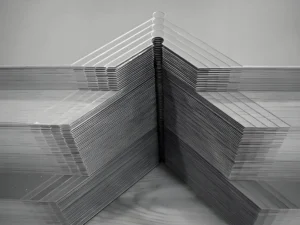
Definition of Core Laminations
What are core laminations?
Core laminations are thin sheets of electrical steel stacked together to form the core of transformers and other electrical equipment. These laminations are designed to minimize energy losses due to eddy currents, which are circulating currents induced within the core by the alternating magnetic field. The individual sheets are insulated from each other to restrict the flow of eddy currents, thus improving the efficiency of the transformer.
Importance in Transformers and Electrical Equipment
Core laminations play a crucial role in the performance and efficiency of transformers and other electrical devices. By reducing eddy current losses, they enhance the overall energy efficiency of the equipment, ensuring that more electrical energy is converted into usable power rather than being lost as heat. This not only improves the performance of the device but also contributes to energy savings and operational cost reductions. Additionally, well-designed core laminations help in maintaining the reliability and longevity of electrical equipment, making them an indispensable component in modern electrical engineering.
Understanding Core Laminations
Types of Steel and Other Materials
Core laminations are primarily made from specific types of electrical steel, known for their magnetic properties and efficiency. The most common types include:
- Grain-Oriented Electrical Steel (GOES): This type of steel is specially processed to have a uniform grain structure, which enhances its magnetic properties and reduces core losses. It is widely used in power transformers due to its high efficiency.
- Non-Grain-Oriented Electrical Steel (NGOES): Unlike GOES, this steel has a random grain structure. It is used in applications where magnetic properties are needed in multiple directions, such as in motors and smaller transformers.
- Amorphous Steel: This steel is made by rapidly cooling molten metal, which prevents the formation of a crystalline structure. It has lower core losses compared to traditional electrical steel, making it suitable for high-efficiency transformers.
Properties That Make These Materials Suitable
The suitability of these materials for core laminations is due to their unique properties:
- High Permeability: These steels have a high magnetic permeability, allowing them to efficiently channel magnetic flux.
- Low Core Losses: Both GOES and amorphous steel exhibit low hysteresis and eddy current losses, which is critical for efficient transformer operation.
- Mechanical Strength: These materials are durable and can withstand the mechanical stresses during the manufacturing and operation of transformers.
- Thermal Stability: They maintain their properties over a wide range of temperatures, ensuring reliable performance in various operating conditions.
Benefits
Efficiency Improvement
Core laminations significantly improve the efficiency of transformers by reducing eddy current losses. Eddy currents are loops of electrical current induced within the core by the alternating magnetic field. These currents generate heat, leading to energy losses. By dividing the core into thin, insulated layers, core laminations restrict the path of eddy currents, thereby reducing their magnitude. The insulation between the laminations prevents the flow of these currents from one lamination to another, further minimizing energy losses.
The reduction of eddy current losses directly impacts the overall performance of a transformer. With lower energy losses, more electrical power is converted into usable output, enhancing the transformer’s efficiency. This efficiency translates to lower operational costs and improved reliability. Additionally, the reduction in heat generation helps maintain optimal operating temperatures, which prolongs the lifespan of the transformer components and reduces the need for extensive cooling systems.
Energy Loss Reduction
Transformers experience two main types of energy losses: hysteresis losses and eddy current losses.
- Hysteresis Losses: These occur due to the lag between changes in the magnetic field and the magnetization of the core material. Each cycle of magnetization results in a small amount of energy loss due to the friction-like resistance within the material.
- Eddy Current Losses: These are caused by induced currents circulating within the core material, which generate heat and lead to energy dissipation.